
Bethnal Green is a London Overground station on the Lea Valley lines in the southern part of Bethnal Green, in East London. The station is 1 mile 10 chains down the line from London Liverpool Street; the next station is either Hackney Downs or Cambridge Heath. It is an interchange station between three services operated by London Overground. Its three-letter station code is BET and it is in Travelcard zone 2.

Southbury is a London Overground station on the Southbury Loop section of the Lea Valley lines, located on the easterly side of Enfield in north London. It is 10 miles 32 chains (16.7 km) down the line from London Liverpool Street and is situated between Edmonton Green and Turkey Street.

Turkey Street is a London Overground station on the Southbury Loop section of the Lea Valley lines, located in the Bullsmoor area to the north of Enfield in north London. It is 12 miles 16 chains (19.6 km) down the line from London Liverpool Street and is situated between Southbury and Theobalds Grove.

The Lea Valley lines are two commuter lines and two branches in north-east London, so named because they run along the Lower Lea Valley of the River Lea. They were part of the Great Eastern Railway, now part of the Anglia Route of Network Rail.

Cheshunt is a National Rail and London Overground station in Cheshunt, Hertfordshire, England. On the National Rail network it is on the West Anglia Main Line, 14 miles 1 chain (22.6 km) from London Liverpool Street and situated between Waltham Cross and Broxbourne. On the London Overground network it is one of three northern termini of the Lea Valley lines.

Theobalds Grove is a London Overground station on the Southbury Loop section of the Lea Valley lines, located in Waltham Cross, Hertfordshire. The station is named after the nearby Theobalds Palace grounds. It is 13 miles 45 chains (21.8 km) down the line from London Liverpool Street and is situated between Turkey Street and Cheshunt, the northern terminus.

Waltham Cross railway station is on the West Anglia Main Line, serving the suburban town of Waltham Cross in Hertfordshire, and the neighbouring Waltham Abbey in Essex, England. It is 12 miles 63 chains (20.6 km) down the line from London Liverpool Street and is situated between Enfield Lock and Cheshunt. Its three-letter station code is WLC and it is in Travelcard zone 7.

The West Anglia Main Line is one of the two main lines that operate out of Liverpool Street. It runs generally north through Cheshunt, Broxbourne, Harlow, Bishop's Stortford and Audley End to Cambridge, with branches between serving Stratford, Hertford and Stansted Airport. The line runs along the boundary between Hertfordshire and Essex for much of its length.

The Mayflower line is a railway branch line in the east of England that links Manningtree, on the Great Eastern Main Line, to Harwich Town. During peak times, many services connect to or from the main line and its London terminus at Liverpool Street. The Mayflower line has six stations, including the two termini, and is situated within the county of Essex.
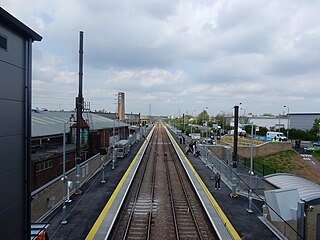
Lea Bridge is a railway station on the line between Stratford and Tottenham Hale on the Lea Valley Lines, which reopened on 15 May 2016 with the full service beginning on 16 May 2016, operated by Greater Anglia.
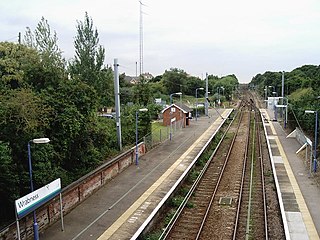
Wrabness railway station is on the Mayflower Line, a branch of the Great Eastern Main Line in the East of England, serving the village of Wrabness, Essex. It is 65 miles 6 chains (104.73 km) down the line from London Liverpool Street and is situated between Mistley to the west and Harwich International station to the east. Its three-letter station code is WRB.

Dovercourt railway station is on the Mayflower Line, a branch of the Great Eastern Main Line, in the East of England, serving the seaside town of Dovercourt, Essex. It is 70 miles 19 chains (113.04 km) from London Liverpool Street and is situated between Harwich International to the west and Harwich Town to the east. Its three-letter station code is DVC.
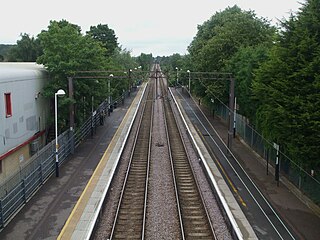
The Chingford branch line is a railway line between Clapton Junction and Chingford station. Services operate between Liverpool Street station and Chingford. The branch is part of the London Overground.
Lower Edmonton railway station was a station in Edmonton, London opened in 1849 by the Eastern Counties Railway as part of the original Enfield Town branch line. Originally named Edmonton it was renamed as Lower Edmonton low level to distinguish it from neighbouring Lower Edmonton high level. It closed to passengers in 1939 although the line on which it stood lasted until 1964.
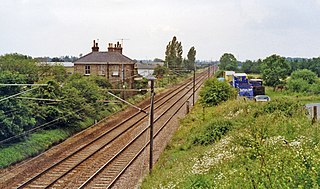
Finningham railway station was a station physically located in the neighbouring parish of Bacton, Suffolk on the Great Eastern Main Line between London and Norwich. It was located 86 miles and 54 chains from Liverpool Street and was opened to passenger in 1849. It was closed in 1966 as part of the Beeching Axe with other smaller stations on the line although the line remains open.

Wragby railway station was a railway station that served the town of Wragby, Lincolnshire, England between 1874 and 1960, on the Louth to Bardney line.
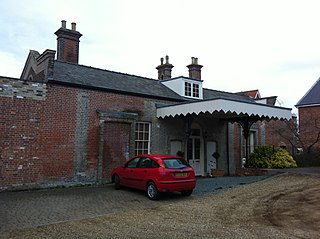
Hadleigh railway station was a station in Hadleigh, Suffolk, the terminus of the Hadleigh Railway, a short branch line from Bentley Junction. The line opened in 1847. The original intermediate stations were at Bentley Church, Capel and Raydon Wood.

Raydon Wood railway station was a station in Suffolk, on a short branch line from Bentley Junction to Hadleigh. There was a goods shed on a passing loop which included a small siding on the south side of the station at the Bentley end.

The Southbury Loop is a line linking Edmonton Green, in north-east London, to Cheshunt. It was opened by the Great Eastern Railway in 1891. Initially it was not very successful and was closed to passenger traffic in 1909. Goods trains continued to use the line and during World War I passenger services were reinstated for munitions workers. Once the war finished the line returned to its goods-only status although it was occasionally used for diversionary purposes when the West Anglia Main Line was closed south of Cheshunt. Electrification of the line and the reintroduction of passenger services in 1960 saw the line become busy with regular suburban services as part of the Lea Valley Lines network. Since May 2015 passenger services on the line are part of London Overground.
The Enfield Town branch is a suburban branch line in the England. In 2014 it is in fact the combination of the original Enfield branch which was built in 1849 by the Eastern Counties Railway (ECR) and a later line built by the Great Eastern Railway (GER) from Hackney Downs to Edmonton in 1872. The line is currently a double-tracked suburban railway with services running between Liverpool Street station and Enfield Town as well as some other services running from Liverpool Street to Cheshunt. Part of the original branch is closed and little visible remains today.


















